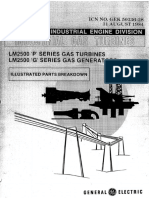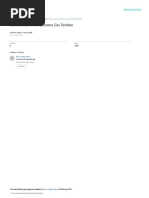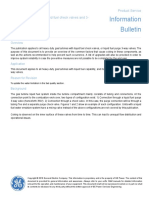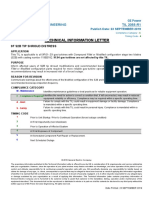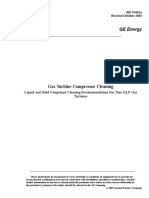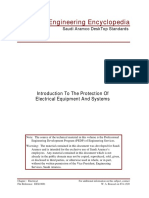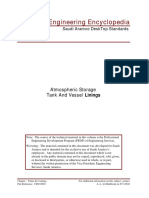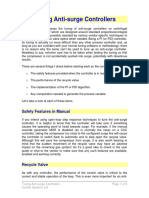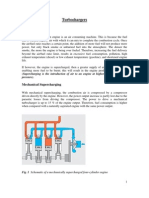Nuovo Pignone: Gas Turbine Compressor Washing
Uploaded by
cvg ertdCopyright:
Available Formats
Nuovo Pignone: Gas Turbine Compressor Washing
Uploaded by
cvg ertdOriginal Title
Copyright
Available Formats
Share this document
Did you find this document useful?
Is this content inappropriate?
Copyright:
Available Formats
Nuovo Pignone: Gas Turbine Compressor Washing
Uploaded by
cvg ertdCopyright:
Available Formats
g
Nuovo Pignone
Gas Turbine Compressor Washing GEK 103623B
Revised May 1996
Gas Turbine Compressor Washing
Liquid Washing Recommendations for DLN Gas Turbines
These instructions do not purport to cover all details or variation in equipment nor to provide for every
possible contingency to be met in connection with installation, operation or maintenance. Should further in-
P. 1
MOD. ARGE 2/S
g
Nuovo Pignone
Gas Turbine Compressor Washing GEK 103623B
formation be desired or should particular problems arise which are not covered sufficiently for the purchaser’s
purpose the matter should be referred to the GE Company.
© 1995 GENERAL ELECTRIC COMPANY
P. 2
MOD. ARGE 2/S
g
Nuovo Pignone
Gas Turbine Compressor Washing GEK 103623B
TABLE OF CONTENTS
I. SCOPE ................................................................................................................. 3
II. INTRODUCTION ............................................................................................... 3
III. TYPES OF FOULING ......................................................................................... 3
IV. METHODS OF DETECTION ............................................................................ 3
A. Visual Inspection................................................................................................ 4
B. Performance Monitoring ..................................................................................... 4
V. WATER AND WATER AND DETERGENT WASHING METHOD ................ 4
VI. ALLOWABLE CONDITIONS FOR WATER WASH ....................................... 5
VII. WASHING AND RESTORATION OF PERFORMANCE ................................ 5
A. Water or Detergent Wash................................................................................... 5
B. Results of Washing............................................................................................. 12
APPENDIX 1. COMPRESSOR WASHING DETERGENT SPECIFICATION . 15
LIST OF TABLES
Table 1. Quality Specification ......................................................................................... 13
Table 2. Water and/or Water and Detergent Solution Injection (Flow) Rates ..................... 14
Table Al. Chemical Content of Washing Detergent............................................................ 17
P. 3
MOD. ARGE 2/S
g
Nuovo Pignone
Gas Turbine Compressor Washing GEK 103623B
I. SCOPE
The scope of this document is to present the methods of compressor washing approved by GE.
Two methods of liquid washing are employed - on line and off line. On-line washing is the proc-
ess of injecting water into the compressor while running at full speed and some percentage of
load. Off-line washing is the process of injecting cleaning solution into the compressor while it is
being turned at cranking speed. The advantage of on-line washing is that it can be done without
having to shut down the machine. On-line washing, however, is not as effective as off-line wash-
ing; therefore, on-line washing is used to supplement off-line washing, not replace it.
This document applies to all gas turbine models offered by Gas Turbine Division and addresses
units operating with DLN systems.
NOTE
It is recommended that a unit-specific procedure and checklist be created by each
customer. The procedure and checklist should include configuring the unit for water
wash, performing water wash and restoration following water wash. These proce-
dures should conform to the enclosed general guidelines. Technical assistance can
be provided by General Electric in preparing the unit specific procedures and check-
lists.
II. INTRODUCTION
A loss of gas turbine performance is indicated by a decrease in power output and an increase in
heat rate.
Often a loss of performance is a direct result of fouling of the axial flow compressor. Fouled
compressors result in reduced air flow, lower compressor efficiency and a lower compressor
pressure ratio.
Compressor washing will remove fouling deposits and restore performance. It should be noted
that full power may not always be regained once significant fouling occurs. Regular compressor
washing will help maintain performance. Specific intervals must be determined based on cus-
tomer performance. Compressor washing may also slow the progress of corrosion, thereby in-
creasing blade life and reducing the contribution of corrosion products to the formation of fouling
deposits.
III. TYPES OF FOULING
The type and rate of fouling of an axial compressor depends on the environment in which it oper-
ates and the filtration present.
Experience has shown that fouling deposits consist of varying amounts of moisture, oil, soot, wa-
ter-soluble constituents, insoluble dirt and corrosion products of the compressor blading material.
Fouling deposits are probably held together by moisture and oil. If corrosion of the bla ding is oc-
curring, the corrosion products will promote and stabilize the deposit.
It is important to minimize fouling deposits by reducing oil leaks and the ingestion of oily constitu-
ents (lube oil fumes). Good filtration may greatly reduce fouling. Moisture formation cannot be
reduced in humid environments. Moisture is formed in the compressor inlet when humid air is
cooled below its dew point as a result of being accelerated to about Mach = 0.5. GER 3601, "Gas
P. 4
MOD. ARGE 2/S
g
Nuovo Pignone
Gas Turbine Compressor Washing GEK 103623B
Turbine Compressor Operating Environment and Material Evaluation", discusses the factors in-
fluencing compressor fouling and corrosion.
P. 5
MOD. ARGE 2/S
g
Nuovo Pignone
Gas Turbine Compressor Washing GEK 103623B
IV. METHODS OF DETECTION
There are two basic methods for determining the cleanliness of the compressor. visual inspection
and performance monitoring are described below.
A. Visual Inspection
Visual inspection involves shutting the unit down; removing the inlet plenum inspection hatch;
and visually inspecting the compressor inlet, bellmouth, inlet guide vanes and early stage bla d-
ing.
If any deposits, including dust or filmy deposits, can be wiped or scraped off these areas, the
compressor is fouled sufficiently to affect performance. The initial inspection also reveals
whether the deposits are oily or dry. For oily deposits, a water-detergent wash is required.
Location of the source of the oil and correction should be accomplished before washing to
prevent recurrence of the fouling.
If only dry deposits are found, water alone may be sufficient.
B. Performance Monitoring
A second method for detecting a fouled compressor is performance monitoring. Performance
monitoring involves obtaining gas turbine data on a routine basis, which in turn is compared to
base line data to monitor trends in the performance of the gas turbine.
The performance data is obtained by running the unit at steady-state BASE load and re-
cording output, exhaust temperature, inlet air temperature, barometric pressure, compressor
discharge pressure and temperature, and fuel consumption. The data should be taken carefully
with the unit warmed up.
GEK 28166, "Field Performance Testing Procedure," can be used as a guide for assessing
machine performance both before and after cleaning the compressor. The purpose of this par-
ticular document is to establish the performance of generator drive machines. The appropriate
portions can, however, also be used for all machines, both generator drive and other applica-
tions, for assessing cleaning effectiveness.
Output and heat rate can be corrected to a standard condition using the turbine performance
curves, and an analysis can be made of compressor pressure ratio and efficiency. The current
performance levels can be compared to base line data and will aid in determining the problem
area.
If performance analysis indicates compressor fouling, it should be verified by a visual inspec-
tion.
V. WATER AND WATER AND DETERGENT WASHING METHOD
It is recommended that on-line water washing be addressed in the facility's operating air permit.
Regulators may interpret this as an additional short-term emissions source, requiring an exemption
similar to that provided for start-up, shutdown and transient conditions.
The compressor is washed with water and/or water and detergent solution. This can be accom-
plished while the turbine is on line or off line. As the on-line washing practice has been found to
be most effective when carried out daily, the specification on the liquid must be more restrictive
P. 6
MOD. ARGE 2/S
g
Nuovo Pignone
Gas Turbine Compressor Washing GEK 103623B
for on-line washing than off-line washing. The water specifications for off-line and on-line clean-
ing are given in Table 1.
It is recommended that on-line water washing be performed without the use of detergent. The
detergent effectiveness during on -line wash is limited as there is no soak time as there is for off-
line wash.
Except for the pH, the restrictions in these specifications are concerned with deposits and corro-
sion of the hot gas path. The pH restriction is concerned with corrosion in the water-handling sys-
tem. High-purity demineralized water after contact with air will have a pH in the range of 5.0 to
6.0. Thus, allowance has been made in the pH provided this is the reason for the low pH.
If a detergent is used, additional restrictions are required to ensure no harm will result to turbine
components. These are given in Appendix 1.
In general, deposits will contain some water-soluble material and oils. The latter will be more
amenable to removal by detergent, but the deposit may be removable by water washing alone,
depending on the amount of water-soluble material present. Hot water at 150 to 200°F (66-93°C)
is generally more effective than cold water.
There are a number of detergents commercially available for this purpose, some of which, along
with the deposits that have been removed, may constitute a hazardous solid waste (as defined by
the US Environmental Protection Agency) when used for an off-line wash. Because of this pos-
sibility, local regulations should be considered for the storage, handling and treatment of the water
wash effluent when the drain and containment system is designed.
VI. ALLOWABLE CONDITIONS FOR WATER WASH
For an on-line wash the compressor inlet temperature, CTIM from the Speedtronic panel, must
be greater than 50°F (10°C). CTIM must be measured with inlet bleed heat off. Refer to TIL
1153-3 for guidance on performing cold weather on-line washing.
On-line water washing should not be performed while inlet bleed beat is operating for any reason.
Do not force inlet bleed heat off to satisfy this restriction. If inlet bleed heat turns on for any rea-
son while washing, the water wash procedure should be suspended.
For off-line water wash the operator must take appropriate precautions to prevent freezing in the
compressor inlet, gas turbine, exhaust and drain system. Off-line water washing should not be
done at compressor inlet temperatures, CTIM, less than 400F (40C), measured while cranking.
VII. WASHING AND) RESTORATION OF PERFORMANCE
A. Water or Detergent Wash
1. Off-Line Compressor Wash
The intention of this procedure is to isolate all air extraction points and drain all low points.
It is recognized that additional isolations and drains may be required depending on specific
systems, equipment and customer supplied equipment and interconnect piping.
It is recommended that the customer develop a customized checklist for the preparation
and restoration of the gas turbine for an off-line water wash.
P. 7
MOD. ARGE 2/S
g
Nuovo Pignone
Gas Turbine Compressor Washing GEK 103623B
Off-line compressor water wash is required if compressor performance degrades 10% due
to fouling.
P. 8
MOD. ARGE 2/S
g
Nuovo Pignone
Gas Turbine Compressor Washing GEK 103623B
a. Preparation
1) Off-line washing solution must meet the requirements of both Table 1 and Appendix
1.
2) The cooldown procedure must be continued until the wheelspace temperatures are
within 120°F (67°C) of the wash water temperature.
CAUTION
To prevent thermal shock, wheelspace temperature must be no more than
120°F (67°C) greater than the wash water temperature. If cool water is used
[50°F (10°C)], the wheelspace temperature must not exceed 170°F (77°C).
If hot water [180°F (82°C)] is used, the wheelspace temperature must not
exceed 300°F (149°C).
3) If a unit is equipped with off-base atomizing air compressor, the compressor should
be deenergized during the wash and rinse cycles.
4) Open inlet guide vanes, if applicable.
5) Close flame detector valves or blank-off. Water will foul the flame scanners and
make starting difficult.
6) When regenerators are present, the gas-side face must be covered and kept dry dur-
ing compressor washing to prevent wetting regenerator deposits. These deposits
may change form when wet and become extremely difficult to remove. Leave ac-
cess doors open while cranking to provide an air exhaust path.
7) Fuel manifold drains are to remain closed during wash to prevent water from enter-
ing. Open during dry cycle.
8) Manually isolate systems, open drains and divert drains as follows:
a) The flow through the false start drain valves (VA17) must be diverted from the
sludge tank to a wash water effluent tank on turbines that operate on liquid fuel
or have the capability to.
NOTE
The false start drain flow or any flow that goes normally to the sludge
tank must be diverted from its "normal" path into the sludge tank, into the
wash water effluent drain to prevent an overflow of the sludge tank. In
addition, the false start drain effluent should be visible to evaluate the ef-
fectiveness of the wash cycle. On gas-only machines, there will be no
sludge tank; only a wash water effluent tank.
b) Arrange valves in the exhaust plenum drain piping to divert effluent from the
sludge tank to the waste water tank. Open the main wash water drain valve at
the bottom of the exhaust plenum.
P. 9
MOD. ARGE 2/S
g
Nuovo Pignone
Gas Turbine Compressor Washing GEK 103623B
c) Open the inlet plenum drain valve.
d) Close valve installed in the AD-2 line supplying compressor discharge air to the
false start drain valve and open downstream drain.
e) Switch the motor controller for the turbine exhaust frame cooling fan motors,
88TK-1 and 88TK-2 in the manual "ON" position (if provided).
NOTE
This step is necessary to prevent water wash from entering the exhaust
frame cooling system during the wash cycle.
The atomizing an system (if provided) is isolated in the following manner:
f) Close valve on inlet side of atomizing air system from AD-8 line.
g) Open all low point drains in the atomizing air supply lines.
h) Open the atomizing air separator drain valve (if provided).
i) Open vent line on inlet side of CA2, booster atomizing air compressor (if pro-
vided).
j) Open switch at the motor control center for 88AB; the drive motor for the
booster atomizing air compressor, CA2.
The cooling and sealing air circuitry is isolated in the following manner:
k) Close valve in the bearing sealing air supply line AE-5 from extraction air (if pro-
vided).
l) Close valve in all compressor discharge pressure transducer supply lines (AD-4).
m) Close AD-1, AD-3 and if provided, AD-6, AD-7 and AD-10.
n) Close valve in the bleed air line (AE-##) from extraction air (if provided). If iso-
lation valve is not provided, isolate with a blank-off plate.
o) Open separator drain valve on bearing sealing air line, if provided.
p) Open needle valve upstream of WW9 connection for drainage during the wash
cycle (low point drain on AD-3), if provided.
q) Open low point drain on bearing sealing air line, if provided.
r) If the turbine has a self-cleaning inlet filter, dose the block valve and open the
drain valve on the self-cleaning inlet filter air line.
The inlet air bearing system is isolated in the following manner:
s) Close VM15-1 manually, or if motorized valve is provided, ensure it is closed.
t) Open all low point drains in the Inlet Air Heating System.
b. Washing Procedure
P. 10
MOD. ARGE 2/S
g
Nuovo Pignone
Gas Turbine Compressor Washing GEK 103623B
Washing can be accomplished using a permanent system (a series of nozzles or a spray
ring mounted in the inlet plenum) or with a manual system (a hand-held hose and spray
nozzle). With either system, take care to cover the full circumference of the bell-mouth.
The inlet plenum and bell-mouth should be cleaned first to prevent these deposits from
being washed into the compressor during the cleaning.
Washing with water or detergent should be done at crank speed. Flow rates are given
in Table 2. Utilize the detergent wash procedures which follow:
1) Select the Water Wash control display on the turbine control panel CRT Select
OFF-LINE WATER WASH ON.
At this time, the turbine is prohibited from firing.
2) Place the Master Select Switch in the CRANK position.
3) Initiate a turbine START signal.
4) The turbine will accelerate to full continuous cranking speed. The cranking motor
will maintain the unit on crank until the stop signal is given.
5) Apply solution at the rate specified in Table 2.
6) Apply the solution at crank speed for three to five minutes, shut unit down, continue
spraying during coastdown until the solution is no longer drawn into the compressor
inlet.
7) Allow the detergent to soak for 20 minutes and rinse with water at crank speed for
15 to 20 minutes following the recommended flow rates of Table 2.
c. Washing Effectiveness
The effectiveness of the wash and the rinse can most easily be evaluated by observing
the runoff from the drains during the rinse and visual inspection of the compressor inlet
at the end of a wash cycle.
1) The compressor should be rinsed until the drain water appears clean.
2) The runoff water may also be checked for the amount of impurities it contains by
measuring its electrolytic conductivity. The conductivity value will decrease as
washing continues and the runoff water contains fewer dissolved impurities.
3) Another method of testing is to use an atomic absorption spectrometer if one is
available for checking the level of trace metals.
NOTE
The detergent wash may need to be repeated depending on the amount
of fouling and detergent effectiveness. Multiple washes will be required
if the compressor is heavily fouled.
d. Draining and Drying Procedure
P. 11
MOD. ARGE 2/S
g
Nuovo Pignone
Gas Turbine Compressor Washing GEK 103623B
1) Allow the gas turbine to drain and dry for about 20 minutes including coasting down
time.
2) Open fuel manifold drains and open all low point drains in atomizing air system, fuel
system and purge system.
NOTE
The interconnecting piping is often the low point trap and this piping
must be drained by removing drain plugs or parting pipe flanges. The
low point can be in the inter-connecting piping or the manifold itself de-
pending on the piping design and location of the gas valves. Additionally,
lower combustion can flexible hoses may trap water and may require
flange disassembly to remove water at these locations.
Following water wash and rinse cycles, the dry-out crank cycle should
continue until no water is observed draining from any low point drain.
Following restoration of the piping, the subsequent turbine restart should
be carefully monitored and any operational abnormalities during restart
that might indicate that all wash water has not been drained should result
in an operator trip of the unit and further draining and purging of the pip-
ing to insure all water is removed.
3) After the turbine has stopped, and drying time is complete, initiate a turbine START
signal with the master operation selector switch in the CRANK position.
4) Allow the turbine to accelerate to crank speed.
5) Allow the turbine to dry for at least 20 minutes or until low point drains are dry at
crank speed.
6) Initiate a turbine STOP signal.
e. Restoration
1) If applicable, dose inlet guide vanes.
2) If applicable, reenergize off-base atomizing air compressor and remove regenerator
cover.
3) Close fuel manifold drains.
CAUTION
It is important that the line that allows waste fuel to drain to the sludge tank
be kept open after water washing and during normal turbine startup and op-
eration, so that fuel or water which may accumulate in the exhaust plenum
can continuously drain out of the plenum. Accumulation of waste fuel in the
exhaust plenum is potentially hazardous.
4) Open the hand valves or remove blank-off plates on flame detectors.
5) Return the following manual valves to their previous position in the order listed:
P. 12
MOD. ARGE 2/S
g
Nuovo Pignone
Gas Turbine Compressor Washing GEK 103623B
a) Return the three-way false start drain valve, combustion system and turbine shell
valves from water drain to fuel drain (if installed).
b) Rearrange valves installed in the exhaust plenum drain piping to divert effluent
from the wash water tank to the sludge tank (if applicable).
c) Close the inlet plenum drain valve (if provided).
NOTE
This is important to prevent intake of dirt etc., into the compressor.
d) Open valve installed in the AD-2 line supplying compressor discharge air to the
false start drain valves.
e) Switch the motor controller for the turbine exhaust frame cooling fan motors
88TK-1 and 88TK-2, into the "AUTO" mode (if provided).
The atomizing air system is reenergized in the following manner:
f) Open valve on inlet side of atomizing air system from AD-8 line.
CAUTION
It is critical that this valve be opened to prevent damage to the turbine.
g) Close all low point drains in the atomizing air lines.
h) Close the atomizing air separator drain valve (if provided).
i) Close vent line on inlet side of CA2, booster atomizing air compressor (if pro-
vided).
j) Close switch at the motor control center for 88AB; the drive motor for the
booster atomizing air compressor CA2.
The cooling and sealing air circuitry is reengaged in the following order:
k) Open valve in the bearing sealing air supply line AF-5 from extraction air (if pro-
vided).
CAUTION
It is critical that this valve be opened to prevent damage to the turbine.
l) Open valves in all compressor discharge pressure transducer supply lines (AD-
4).
CAUTION
It is critical that this valve be completely opened to prevent damage to the
turbine.
m) Open AD-1, AD-3, AD-6, AD-7 and AD-10 (if provided).
P. 13
MOD. ARGE 2/S
g
Nuovo Pignone
Gas Turbine Compressor Washing GEK 103623B
CAUTION
In configurations where AD-6 is used to supply the purge air system, it is
critical that this valve be opened to prevent damage to the turbine.
n) Open valves or remove blank-off plate in the bleed air lines (AE-##) from ex-
traction air.
CAUTION
It is critical that these valves be opened to prevent damage to the turbine.
o) Close separator drain valve on bearing sealing air line (if provided).
p) Close needle valve upstream of WW9 connection (low-point drain on AD-3), if
provided.
q) Close low-point drain on bearing sealing air line, if provided.
r) If the turbine has a self-cleaning inlet filter, open the block valve and dose the
drain valve on the self-cleaning filter air line.
The inlet air heating system is reengaged in the following manner:
s) Open VM15-1 manually, or if motorized valve is provided, ensure it is opened.
t) Close all low point drains in the Inlet Air Heating System.
6) Press the Off-Line Water Wash OFF soft switch on the water wash control display.
NOTE
When the OFF-LINE WATER WASH OFF is selected, the permissive
is in place to allow the turbine to fire and the permissive is removed to
allow the 20TW-1 valve to be opened.
2. On-Line Compressor Wash
The intent of on-line washing is to extend the period between off-line washes through fre-
quent washings of short duration. When the compressor is suspected of being heavily
fouled, an off-line wash should be performed.
On line water washing may result in a fogging over of flame detector lenses. For units op-
erating with DLN systems this has the potential of resulting in tripping the turbine off line.
In order to assure uninterrupted turbine operation the following set-up procedure should be
followed for units operating with DLN systems.
While observing Flame Detector Level Intensity on the Mark V display, start water wash
with throttled back flow, slowly increase until intensity is decreased to a comfortable mar-
gin above drop out level or maximum flow (table 2) is reached, which ever occurs first.
P. 14
MOD. ARGE 2/S
g
Nuovo Pignone
Gas Turbine Compressor Washing GEK 103623B
Adding water for wash will increase the compressor pressure ratio and thus reduce the
surge margin. Under normal circumstances, there is ample surge margin to allow for wash-
ing and steam or water injection for NOx control or power augmentation. However, the
following steps are recommended prior to performing an on-line wash.
a. Preparation
1) On-line washing solution must meet the requirements of both Table 1 and Appendix
1.
2) Turbine must be running at full speed and not in the process of shutting down.
3) Compressor inlet temperature, CTIM, must be greater than 50°F (10°C). Refer to
TIL 1153-3 for information on cold weather on-line water wash. On-line water
washing should not be per-formed while inlet bleed heat is operating for any reason.
Do not force inlet bleed heat off to satisfy this restriction
4) Set the inlet guide vanes to 81° or greater. For units operating with DLN Systems,
full open position occurs only at base load.
5) Reduce load by 5% if operating at base load. Units operating with DLN systems
need not reduce load and must perform compressor wash at base load to achieve
full open IGV's.
6) Units operating with water or steam injection for NOx control or power augmenta-
tion must reduce water or steam injection to 3% maximum of compressor inlet flow.
7) For units operating with DLN Systems, washing is to be conducted while in Ex-
tended Lean-Lean or Premix combustion modes.
NOTE
Operating in extended lean-lean will result in increased emissions over
premix operation.
b. Washing Procedure
1) Apply water at the rate specified in Table 2.
2) Continue to apply solution for 30 minutes.
3) On-line wash is most effective when performed on a regular basis.
4) If inlet bleed heat turns on for any reason while washing, the water wash procedure
should be suspended.
NOTE
If using a detergent solution for on-line washing, it is recommended that
the wash be followed by enough rinse water to remove the detergent
residue from the wash nozzles at the spray manifold. This will prevent
the detergent solutions from drying and clogging the nozzles.
P. 15
MOD. ARGE 2/S
g
Nuovo Pignone
Gas Turbine Compressor Washing GEK 103623B
B. Results of Washing
After cleaning, there should be a noticeable increase in performance. Increase in performance
is a function of how fouled the compressor was initially. An increase in BASE load power of
10% is not uncommon following an off-line wash. This can be confirmed by comparing re-
stored performance data to levels of performance before washing, utilizing the procedure in
GEK 28166 for generator drive machines and the appropriate procedure for other applications
as previously described under Performance Monitoring. It should be noted that full power may
not always be regained once significant fouling occurs. Regular compressor washing will help
maintain performance. Specific intervals must be determined based on customer performance.
P. 16
MOD. ARGE 2/S
g
Nuovo Pignone
Gas Turbine Compressor Washing GEK 103623B
TABLE 1
QUALITY SPECIFICATION*
OFF-LINE WASHING
TOTAL SOLIDS (dissolved and undissolved) l00 ppm
TOTAL ALKALI METAL 25 ppm
OTHER METALS WHICH MAY PROMOTE 1.0 ppm
HOT CORROSION (i.e. lead, vanadium)
pH (determined by glass electrode) 6.5 to 7.5
ON-LINE WASHING
TOTAL SOLIDS (dissolved and undissolved) 5 ppm
TOTAL ALKALI AND OTHER METALS WHICH 0.5 ppm
MAY PROMOTE HOT CORROSION
pH (determined by glass electrode) 6.5 to 7.5
See Table Al in Appendix 1 for chemical specifications.
Applies to water or water and detergent solution
P. 17
MOD. ARGE 2/S
g
Nuovo Pignone
Gas Turbine Compressor Washing GEK 103623B
TABLE 2
WATER AND/OR WATER AND DETERGENT SOLUTION
INJECTION (FLOW) RATES
Off Line (1) ON Line (1)
Machine Temp Flow
Press Flow Press Temp
(°F) (GPM)
(psig) (GPM) (psig) (°F)
max.
MS3001, 3002 115 150-180 15 100 50-180 3.5
MS5001, 5002 85 150-180 35 100 50-180 8
MS6001 85 150-180 42 100 50-180 10
MS6001F/FA 85 150-180 45 100 50-180 13
MS700lEA 85 150-180 50 100 50-180 18
MS7001F/FA 85 150-180 81 100 50-180 26
MS900lE 85 150-180 72 100 50-180 26
MS900lF/FA 85 150-180 117 100 50-180 38
1
Mixed at manufacturer's suggested mix ratio.
P. 18
MOD. ARGE 2/S
g
Nuovo Pignone
Gas Turbine Compressor Washing GEK 103623B
APPENDIX 1
COMPRESSOR WASHING DETERGENT SPECIFICATION
1.0 Scope
1.1 This specification is for cleaning compounds for use in compressor washing. It is required
that these compounds will not cause harm to gas turbine components. Thus, their purity
and composition must be such that they do not cause aqueous corrosion or stress corrosion
of compressor materials. Also, it is required that they do not cause hot corrosion in the tur-
bine. Furthermore, they must not lead to compressor fouling. With regard to the cleaning
agents themselves, they must be chemically stable in themselves and in their mixtures with
water. Also, they must not form combustible mixtures and they should satisfy all local
codes relative to health and safety requirements. Compliance with this specification does
not imply a cleaning compound improves the cleaning of a compressor over and above
what can be obtained from water alone.
2.0 Requirements
2.1 The cleaning compound when mixed with water in the manufacturer's prescribed concen-
tration shall satisfy the water washing specifications for on-line and off-line water quality
given in Table 1. In the pure state it shall satisfy the specification given in Table Al.
2.2 The residue or ash content of the cleaning compound shall not exceed 0.01%. See test 4.1.
2.3 The storage stability of the cleaning compound shall show no marked color change, shall
not separate and shall not corrode or stain the steel specimen when tested as specified in
test 4.5.16 of MIL-C-85704A. This test is given in 4.2.
2.4 The cleaner and its mixtures with water shall not form gums under compressor conditions.
2.5 The Pensky-Martens flash point of the cleaning compound shall be above 1400F (600C)
(ASTM D93).
3.0 Material Compatibility
3.1 Use of the cleaning compound shall not have adverse effects on engine system materials
such as compressor or turbine materials.
4.0 Tests
4.1 Ash content: preparation of test samples
P. 19
MOD. ARGE 2/S
g
Nuovo Pignone
Gas Turbine Compressor Washing GEK 103623B
Approximately 10 g of cleaning compound shall be weighed to the nearest 0.1 mg in a
tared porcelain crucible. The crucible shall be heated at 221°± 2°F (105° ± 1°C) for 24
hours, then heated at 464° ± 4°F (240° ± 2°C) for the next 24 hours.
P. 20
MOD. ARGE 2/S
g
Nuovo Pignone
Gas Turbine Compressor Washing GEK 103623B
Following this, the crucible and its contents shall be carefully ignited over a Bunsen-type
gas burner. The crucible shall then be placed in a muffle furnace at 1,900°F (1,040°C) for
2 hours. The crucible shall be transferred to a desiccator, cooled and weighed until con-
stant weight. The ash content shall be calculated as the percentage of the initial weight of
cleaning compound.
4.2 Accelerated storage stability (from MIL-C-85704A)
Preparation of test sample. A 150-ml portion of a well-shaken cleaning compound shall
be poured into each of two chemically clean 250-ml pressure-resistant clear glass bottles
which shall be approximately 9.5 inches (24.1 cm) in height and 2.5 inches (6.4 cm) in out-
side diameter. One bottle shall be capped and stored in the dark for at least six days at
room temperature. A strip of steel 6 by 0.5 by 0.02 inches (15.2 x 1.3 x 0.05 cm) conform-
ing to MIL-S-7952 shall be polished to remove surface contamination and then cleaned by
boiling for one minute in chemically pure isopropyl alcohol and one minute in mineral spirits.
The steel strip shall be placed in the other test bottle and the bottle shall be capped. The
capped bottle containing the steel strip shall be thoroughly shaken for one minute.
Procedure. The capped bottle containing the steel strip shall be placed in a water bath and
heated at a uniform rate to a temperature of 140° ± 4°F (60° ± 2°C) over a period of five
hours. It shall be held at this temperature for three hours. No heat shall be applied to the
bath overnight. The above heating procedure shall be repeated each day for five days.
(This test need not necessarily be attended if an interval time is used to regulate the tem-
perature automatically. The test may be started on a Wednesday, Thursday or Friday and
still have the pressure bottle removed on a normal workday.) On the morning of the sixth
day, the bottle shall be removed from the bath, uncapped, examined for separation and the
steel strip carefully withdrawn from the cleaning compound. Separation into layers shall be
cause for rejection.
The portion of the steel strip which had been immersed in the compound shall be examined
for evidence of pitting, corrosion and uneven darkening. The open bottle shall be capped
and the two bottles shall be thoroughly shaken for one minute, then allowed to remain un-
disturbed for one hour at room temperature and then examined. Any marked change in the
color and uniformity of the aged sample shall be considered as showing unsatisfactory sta-
bility properties.
P. 21
MOD. ARGE 2/S
g
Nuovo Pignone
Gas Turbine Compressor Washing GEK 103623B
TABLE Al
CHEMICAL CONTENT OF WASHING DETERGENT
Total alkali metals 25 ppm
Magnesium + calcium 5 ppm max
Vanadium 0.1 ppm max
Lead 0.1 ppm max
Tin + copper 10 ppm max
Sulfur 50 ppm max
Chlorine 40 ppm max
P. 22
MOD. ARGE 2/S
You might also like
- Gas Turbine Compressor Washing: GE EnergyNo ratings yetGas Turbine Compressor Washing: GE Energy18 pages
- F Class Gas Turbine Compressor Water Wash System100% (4)F Class Gas Turbine Compressor Water Wash System8 pages
- TM2500 Aero Package Operations-Familiarization 5 Days OE CDB Rev ANo ratings yetTM2500 Aero Package Operations-Familiarization 5 Days OE CDB Rev A2 pages
- GE Gas Power P28A-AL-0001: Ge Class Ii (Internal Non-Critical)100% (1)GE Gas Power P28A-AL-0001: Ge Class Ii (Internal Non-Critical)6 pages
- Brochure Gas Turbine SGT-800 For Power GenerationNo ratings yetBrochure Gas Turbine SGT-800 For Power Generation4 pages
- TIL 2373 - 7E Stage 2 Bucket Tip Shroud DistressNo ratings yetTIL 2373 - 7E Stage 2 Bucket Tip Shroud Distress8 pages
- Technical Information Letter: Energy Services Engineering Product Service TIL 1713No ratings yetTechnical Information Letter: Energy Services Engineering Product Service TIL 17135 pages
- Illustrated Parts Breakdown (GEK 50336-28)No ratings yetIllustrated Parts Breakdown (GEK 50336-28)526 pages
- E Gas Turbine GE10B1 GE10 Heavy Duty Single Shaft Gas Turbine GE Gas Turbine GE10B1 Technical Data Secondhand RefurbishedNo ratings yetE Gas Turbine GE10B1 GE10 Heavy Duty Single Shaft Gas Turbine GE Gas Turbine GE10B1 Technical Data Secondhand Refurbished2 pages
- GEK32568f Lubricating Oil For Gas Turbines Bearing Temp Over 500FNo ratings yetGEK32568f Lubricating Oil For Gas Turbines Bearing Temp Over 500F14 pages
- Inspection Check Document IC-52-B2-1001 Rev: ANo ratings yetInspection Check Document IC-52-B2-1001 Rev: A24 pages
- Technical Information Letter: Dangers of Bearing Refurbishment100% (1)Technical Information Letter: Dangers of Bearing Refurbishment7 pages
- 06 UCH GT 9001E - Inlet Filter & Duct Systems100% (2)06 UCH GT 9001E - Inlet Filter & Duct Systems113 pages
- FT8 - Air System - Maintenance - P&W FT8 - Solar Turbines Technical BLOGNo ratings yetFT8 - Air System - Maintenance - P&W FT8 - Solar Turbines Technical BLOG3 pages
- Equipment Definition: Operation and Maintenance ManualNo ratings yetEquipment Definition: Operation and Maintenance Manual17 pages
- GEI-41042t-GT-Compr-Cleaning-for-Non-DLN-without-Pulsed-OFFWWNo ratings yetGEI-41042t-GT-Compr-Cleaning-for-Non-DLN-without-Pulsed-OFFWW16 pages
- Gas-Engines and Producer-Gas Plants A Practice Treatise Setting Forth the Principles of Gas-Engines and Producer Design, the Selection and Installation of an Engine, Conditions of Perfect Operation, Producer-Gas Engines and Their Possibilities, the Care of Gas-Engines and Producer-Gas Plants, with a Chapter on Volatile Hydrocarbon and Oil EnginesFrom EverandGas-Engines and Producer-Gas Plants A Practice Treatise Setting Forth the Principles of Gas-Engines and Producer Design, the Selection and Installation of an Engine, Conditions of Perfect Operation, Producer-Gas Engines and Their Possibilities, the Care of Gas-Engines and Producer-Gas Plants, with a Chapter on Volatile Hydrocarbon and Oil EnginesNo ratings yet
- Engineering Encyclopedia: Oil Industry Applications of Aas/Aes TechniquesNo ratings yetEngineering Encyclopedia: Oil Industry Applications of Aas/Aes Techniques16 pages
- Engineering Encyclopedia: Fundamental of Radio CommunicationsNo ratings yetEngineering Encyclopedia: Fundamental of Radio Communications12 pages
- Engineering Encyclopedia: Atmospheric Storage Tank and Vessel LiningsNo ratings yetEngineering Encyclopedia: Atmospheric Storage Tank and Vessel Linings18 pages
- Engineering Encyclopedia: Telephone SwitchingNo ratings yetEngineering Encyclopedia: Telephone Switching19 pages
- Engineering Encyclopedia: Exxon Chemical and Mechanical Cleaning Manual 12) Fouling Control by Prepassivation100% (1)Engineering Encyclopedia: Exxon Chemical and Mechanical Cleaning Manual 12) Fouling Control by Prepassivation9 pages
- Engineering Encyclopedia: Structural Steel Codes and StandardsNo ratings yetEngineering Encyclopedia: Structural Steel Codes and Standards23 pages
- Engineering Encyclopedia: Maintenance Paint and Protective Coating SurveysNo ratings yetEngineering Encyclopedia: Maintenance Paint and Protective Coating Surveys24 pages
- Engineering Encyclopedia: Environmental ComplianceNo ratings yetEngineering Encyclopedia: Environmental Compliance25 pages
- Engineering Encyclopedia: Basic Radio SystemsNo ratings yetEngineering Encyclopedia: Basic Radio Systems16 pages
- Engineering Encyclopedia: Exxon Chemical and Mechanical Cleaning Manual 12) Fouling Control by Prepassivation100% (1)Engineering Encyclopedia: Exxon Chemical and Mechanical Cleaning Manual 12) Fouling Control by Prepassivation9 pages
- Engineering Encyclopedia: Lab Experiments in IcpNo ratings yetEngineering Encyclopedia: Lab Experiments in Icp21 pages
- Engineering Encyclopedia: Exxon Chemical and Mechanical Cleaning Manual 6) Precommission Cleaning and PassivationNo ratings yetEngineering Encyclopedia: Exxon Chemical and Mechanical Cleaning Manual 6) Precommission Cleaning and Passivation14 pages
- Engineering Encyclopedia: Introduction To Environmental AwarenessNo ratings yetEngineering Encyclopedia: Introduction To Environmental Awareness21 pages
- Engineering Encyclopedia: Instrument Transformers100% (1)Engineering Encyclopedia: Instrument Transformers30 pages
- Engineering Encyclopedia: Exxon Chemical and Mechanical Cleaning Manual 20) Planning and Control of A Cleaning JobNo ratings yetEngineering Encyclopedia: Exxon Chemical and Mechanical Cleaning Manual 20) Planning and Control of A Cleaning Job14 pages
- Engineering Encyclopedia: Protective Coatings For Corrosion Prevention Beneath Thermal Insulation and ConcreteNo ratings yetEngineering Encyclopedia: Protective Coatings For Corrosion Prevention Beneath Thermal Insulation and Concrete23 pages
- Engineering Encyclopedia: Telephone Support ServicesNo ratings yetEngineering Encyclopedia: Telephone Support Services12 pages
- Tuning Anti-Surge Controllers: Safety Features in Manual100% (2)Tuning Anti-Surge Controllers: Safety Features in Manual6 pages
- Engineering Encyclopedia: Fundamental of Radio CommunicationsNo ratings yetEngineering Encyclopedia: Fundamental of Radio Communications12 pages
- 1237-1 Possible Flexible Hose Installation Errors February 25, 1998No ratings yet1237-1 Possible Flexible Hose Installation Errors February 25, 19984 pages
- Engineering Encyclopedia: Atmospheric Storage Tank and Vessel LiningsNo ratings yetEngineering Encyclopedia: Atmospheric Storage Tank and Vessel Linings18 pages
- 378C: Coverplate Inspection & InstallationNo ratings yet378C: Coverplate Inspection & Installation3 pages
- LEC# 06. Petrol, Diesel, Rankine, Brayton CyclesNo ratings yetLEC# 06. Petrol, Diesel, Rankine, Brayton Cycles33 pages
- Get Gas Turbines Internal Flow Systems Modeling Bijay Sultanian PDF Ebook With Full Chapters Now100% (5)Get Gas Turbines Internal Flow Systems Modeling Bijay Sultanian PDF Ebook With Full Chapters Now62 pages
- Appendix2 EngineeringReportBillPowers PDFNo ratings yetAppendix2 EngineeringReportBillPowers PDF42 pages
- Woodward Industrial Controls Product Line Catalog100% (2)Woodward Industrial Controls Product Line Catalog40 pages
- GE MID-TD-0000-1 Fuel Gases For Combustion in Aeroderivative Gas Turbines75% (4)GE MID-TD-0000-1 Fuel Gases For Combustion in Aeroderivative Gas Turbines11 pages
- 001 Oil Lubrication Presentation Turbine 2No ratings yet001 Oil Lubrication Presentation Turbine 260 pages
- Industrial Training at NTPC Anta Gas Power Plant75% (4)Industrial Training at NTPC Anta Gas Power Plant29 pages
- Lecture 4 - Gas Turbines (Sept 2020) PDFNo ratings yetLecture 4 - Gas Turbines (Sept 2020) PDF6 pages
- Thermal Performance of Combined Cycle Power Plant100% (3)Thermal Performance of Combined Cycle Power Plant12 pages
- Cogeneration & Trigeneration: by Varun Pratap SinghNo ratings yetCogeneration & Trigeneration: by Varun Pratap Singh48 pages
- TM2500 Aero Package Operations-Familiarization 5 Days OE CDB Rev ATM2500 Aero Package Operations-Familiarization 5 Days OE CDB Rev A
- GE Gas Power P28A-AL-0001: Ge Class Ii (Internal Non-Critical)GE Gas Power P28A-AL-0001: Ge Class Ii (Internal Non-Critical)
- Technical Information Letter: Energy Services Engineering Product Service TIL 1713Technical Information Letter: Energy Services Engineering Product Service TIL 1713
- E Gas Turbine GE10B1 GE10 Heavy Duty Single Shaft Gas Turbine GE Gas Turbine GE10B1 Technical Data Secondhand RefurbishedE Gas Turbine GE10B1 GE10 Heavy Duty Single Shaft Gas Turbine GE Gas Turbine GE10B1 Technical Data Secondhand Refurbished
- GEK32568f Lubricating Oil For Gas Turbines Bearing Temp Over 500FGEK32568f Lubricating Oil For Gas Turbines Bearing Temp Over 500F
- Technical Information Letter: Dangers of Bearing RefurbishmentTechnical Information Letter: Dangers of Bearing Refurbishment
- FT8 - Air System - Maintenance - P&W FT8 - Solar Turbines Technical BLOGFT8 - Air System - Maintenance - P&W FT8 - Solar Turbines Technical BLOG
- Equipment Definition: Operation and Maintenance ManualEquipment Definition: Operation and Maintenance Manual
- GEI-41042t-GT-Compr-Cleaning-for-Non-DLN-without-Pulsed-OFFWWGEI-41042t-GT-Compr-Cleaning-for-Non-DLN-without-Pulsed-OFFWW
- Gas-Engines and Producer-Gas Plants A Practice Treatise Setting Forth the Principles of Gas-Engines and Producer Design, the Selection and Installation of an Engine, Conditions of Perfect Operation, Producer-Gas Engines and Their Possibilities, the Care of Gas-Engines and Producer-Gas Plants, with a Chapter on Volatile Hydrocarbon and Oil EnginesFrom EverandGas-Engines and Producer-Gas Plants A Practice Treatise Setting Forth the Principles of Gas-Engines and Producer Design, the Selection and Installation of an Engine, Conditions of Perfect Operation, Producer-Gas Engines and Their Possibilities, the Care of Gas-Engines and Producer-Gas Plants, with a Chapter on Volatile Hydrocarbon and Oil Engines
- Engineering Encyclopedia: Oil Industry Applications of Aas/Aes TechniquesEngineering Encyclopedia: Oil Industry Applications of Aas/Aes Techniques
- Engineering Encyclopedia: Fundamental of Radio CommunicationsEngineering Encyclopedia: Fundamental of Radio Communications
- Engineering Encyclopedia: Atmospheric Storage Tank and Vessel LiningsEngineering Encyclopedia: Atmospheric Storage Tank and Vessel Linings
- Engineering Encyclopedia: Exxon Chemical and Mechanical Cleaning Manual 12) Fouling Control by PrepassivationEngineering Encyclopedia: Exxon Chemical and Mechanical Cleaning Manual 12) Fouling Control by Prepassivation
- Engineering Encyclopedia: Structural Steel Codes and StandardsEngineering Encyclopedia: Structural Steel Codes and Standards
- Engineering Encyclopedia: Maintenance Paint and Protective Coating SurveysEngineering Encyclopedia: Maintenance Paint and Protective Coating Surveys
- Engineering Encyclopedia: Environmental ComplianceEngineering Encyclopedia: Environmental Compliance
- Engineering Encyclopedia: Exxon Chemical and Mechanical Cleaning Manual 12) Fouling Control by PrepassivationEngineering Encyclopedia: Exxon Chemical and Mechanical Cleaning Manual 12) Fouling Control by Prepassivation
- Engineering Encyclopedia: Exxon Chemical and Mechanical Cleaning Manual 6) Precommission Cleaning and PassivationEngineering Encyclopedia: Exxon Chemical and Mechanical Cleaning Manual 6) Precommission Cleaning and Passivation
- Engineering Encyclopedia: Introduction To Environmental AwarenessEngineering Encyclopedia: Introduction To Environmental Awareness
- Engineering Encyclopedia: Exxon Chemical and Mechanical Cleaning Manual 20) Planning and Control of A Cleaning JobEngineering Encyclopedia: Exxon Chemical and Mechanical Cleaning Manual 20) Planning and Control of A Cleaning Job
- Engineering Encyclopedia: Protective Coatings For Corrosion Prevention Beneath Thermal Insulation and ConcreteEngineering Encyclopedia: Protective Coatings For Corrosion Prevention Beneath Thermal Insulation and Concrete
- Engineering Encyclopedia: Telephone Support ServicesEngineering Encyclopedia: Telephone Support Services
- Tuning Anti-Surge Controllers: Safety Features in ManualTuning Anti-Surge Controllers: Safety Features in Manual
- Engineering Encyclopedia: Fundamental of Radio CommunicationsEngineering Encyclopedia: Fundamental of Radio Communications
- 1237-1 Possible Flexible Hose Installation Errors February 25, 19981237-1 Possible Flexible Hose Installation Errors February 25, 1998
- Engineering Encyclopedia: Atmospheric Storage Tank and Vessel LiningsEngineering Encyclopedia: Atmospheric Storage Tank and Vessel Linings
- Get Gas Turbines Internal Flow Systems Modeling Bijay Sultanian PDF Ebook With Full Chapters NowGet Gas Turbines Internal Flow Systems Modeling Bijay Sultanian PDF Ebook With Full Chapters Now
- GE MID-TD-0000-1 Fuel Gases For Combustion in Aeroderivative Gas TurbinesGE MID-TD-0000-1 Fuel Gases For Combustion in Aeroderivative Gas Turbines
- Cogeneration & Trigeneration: by Varun Pratap SinghCogeneration & Trigeneration: by Varun Pratap Singh



















